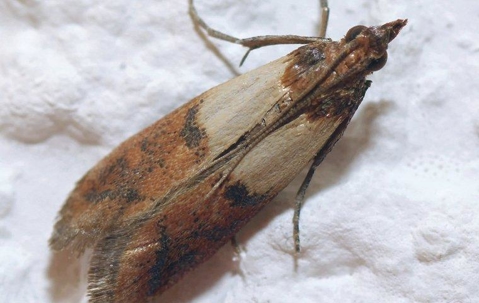You've likely seen pantry moths if you've seen tiny moths of a brownish hue flying around your kitchen or pantry. Do not disregard them as unimportant; moths indicate that you may be dealing with a serious infestation that can destroy your grains and other dry foods.
Pro Active Pest Control provides effective pest control in Gilbert for pantry moths to help you ensure your food remains pantry moth-free.
How To Identify An Indian Meal Moth
The length of an adult Indian meal moth is around 3/8 of an inch, while the wingspan measures approximately 5/8 of an inch. They have an elongated and oval body, and their wings are gray, except for the posterior half of the wing, which has a characteristic rusty bronze tint.
Adults can also be distinguished from juveniles by their characteristic zigzag flight pattern. The larva of the Indian meal moth is typically cream in color, though occasionally, it may have a yellowish or reddish hue. The head of the larva has coloration similar to dark brown.
You Don't Want Pantry Moths In Your Cupboards
Adult moths deposit pantry moth eggs in food that has been stored; pantry moth larvae may have entered the food during the distribution or packaging process. They can reproduce more quickly in humid environments. As soon as they hatch, the larvae start eating. They prefer foods like dry products, grains, fruit, flour, rice, spices, and pet food.
Pantry moths don't transmit human diseases or parasites, but their feces and webbing can contaminate food, and can speed up mold growth. Because of this, you should remove spoiled food as quickly as possible.
How To Get Rid Of An Entire Pantry Moth Infestation
If you've found evidence of a pantry moth infestation, there are some steps you should take to get rid of it:
- First, empty the affected area, removing cans, boxes, bags, and bottles. Examine packaging for small holes. Also, check your jars. Moths can lay eggs under the outer edge of jar lids. Wash any jars found in a contaminated area with hot, soapy water and a scrub brush.
- Discard open dry goods. Toss boxes or bags with holes you didn't make. Examine these carefully; if you've observed even one pantry moth near a cupboard or in your pantry, every non-airtight packaging may be infected.
- Clean the pantry thoroughly. When finished, dump the vacuum bag, tie it in a trash bag, and take it outside. Wash the afflicted area with a vinegar-and-warm-water combination. Add peppermint oil if you have it (pantry moths hate peppermint). Mop the floor.
Wait a few weeks before replenishing the just-cleaned space. This will prevent you from wasting food you bought to replace what you lost. If the problem persists, contact Pro Active Pest Control.
Simple Tips To Prevent Future Indianmeal Moth Infestations
After eliminating the pantry moths, you must take precautions to prevent their return.
- Put dry goods in airtight plastic or glass containers and store away from moisture.
- Leave some peppermint, bay leaves, mint, or cedar chips in the open inside the area; you could even put them in a sachet.
- Inspect cabinets and food storage regularly. Always act quickly to minimize pantry moth spread; we hope you never see them again. One cupboard is easier to clean than every food-containing cabinet in the kitchen.
Last but not least, it is important to point out that pantry moths will frequently hitch a ride back home with you from the supermarket. It's revolting, but it's the truth. Examine the packaging carefully before purchasing flour, cereal, bread, or food for your pet. If your infestation remains, enlist the help of the professionals at Pro Active Pest Control.

